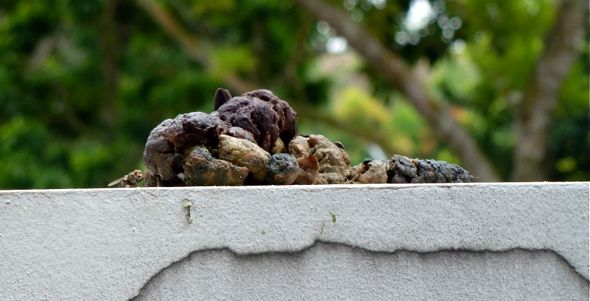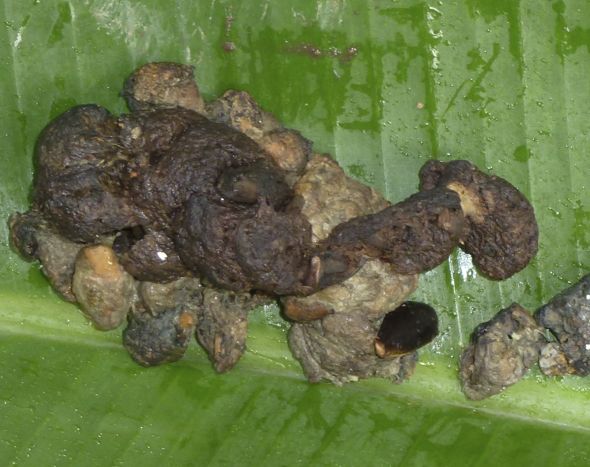“One morning way back in July 2012, I noticed a lump of animal poop on top of the common wall with my next-door neighbour (above). As it looked uncommon, I photographed it. And as it was right next to the front gate I reluctantly removed it.
“With the image of the poop I asked around and was told that it could be that of the Common Palm Civet (Paradoxurus hermaphroditus) (above).
“In February the next year I came across pieces of the shell of the Giant African Snail (Achatina fulica) on the top of the common wall at the back of the garden (above). The shell pieces were dry and clean, with no traces of flesh. Obviously some creature had eaten the snail, leaving pieces of shell behind. Again, I suspected the Common Palm Civet.
“In September this year, I again noticed a small pile of snail shells at exactly the same location. The next month there was a pile of poop, also at the same location (above).
“Overcame with curiousity, I wrote to Dr Vilma D’Rozario whom I knew had Common Palm Civets living in her roof space. She had regularly seen similar shells stripped of flesh in her garden, thus confirming that there was a civet in my garden.
“This was further confirmed by Fung Tze Kwan LINK 1 and LINK 2 and Xu Weiting, both currently researching on the Common Palm Civet at the Department of Biological Sciences, National University of Singapore.
“As for the poop found in my garden, both researchers queried on the presence of seeds. On closer look, there was a black seed of the Chiku (Manilkara zapota). And Tze Kwan confirmed that there were many other smaller beige seeds as well as a civet hair in the poop. This confirmed that the poop was definitely left by the Common Palm Civet.
“The civet had been briefly seen one night last year in the garden but it has yet to be photographed.
“In the meantime I am keeping an eye of more poop as Tze Kwan is researching on the food the civet takes. Should anyone come across such poop in Singapore, please inform her at [email protected] and she will arrange to collect them. Details required include date, location and close-up photo.
“In a next posting more details will be provided on how to recognise the poop, how to bag it and the detailed information to accompany the specimen. In the meantime please keep an eye of the possible presence of the Common Palm Civet and its poop in and around your area.”
YC Wee with Dr Vilma D’Rozario, Fung Tze Kwan & Xu Weiting
Singapore
October 2014
Note: Image of Common Palm Civet by Fung Tze Kwan, others by YC Wee.



![CommonPalmCiver [FungTzeKwan] - 1](https://besgroup.org/wp-content/uploads/CommonPalmCiver-FungTzeKwan-1.jpg)
![garden snail shell [wyc]](https://besgroup.org/wp-content/uploads/garden-snail-shell-wyc.jpg)








9 Responses
The palm civet is also very common in Kerala, India, having adapted itself to live in towns and cities and has a habit of generally defecating on parapet and compound walls. It is attracted to many ornamental palms especially during the fruiting season.
Does anyone produce civet coffee in Kerala?
According to a news item that appeared a few months ago, “Though Kerala, Karnataka and Tamil Nadu (coffee growing states in India) are home to civet cats, there is only one producer of this coffee in India and the annual output is only around 100 kg”. I would be able to get more authentic information on this aspect during December 2014 when I would be meeting coffee planters, managers and researchers at a symposium.
Thanks for the info.
Vietnam is well renowned for its Civet’s roasted coffee beans and sold openly in markets. Apparently, it has become so commercialised, Musangs -not sure which particular species are specially reared in farms to harvest their coffee beans from their poops. And…coffee connoisseurs are prepared to pay a small fortune for them for its superior quality! So much talk about it, I gave it a try in HCM and purchased small bean packets for friends with great appetite for coffee.
Whether the end user actually got the real stuff or not…I suppose it depends on how good the marketing strategy goes. Personally, A good Brazilian roast is just as good and fresh as when one sits outside a coffee producing factory and take in the whiffs of aromatic roast direct from its kilns.
Cheers!
Daisy
We will be posting an account of these “shit-coffee” soon. And in kopi luwak, how the civets are cruelly caged, etc.
Please do not support the Civet Coffee industry. As our good Webmaster says, the civets are cruelly caged. And not only that, they suffer after being force-fed a diet of nothing but coffee berries. Civets are general feeders, with a widely varied diet of both plant and animal matter. In the days when it was still legal to keep wild animals as pets in Singapore, and when the good Webmaster and I were both students at the University of Singapore, a couple of orphaned baby civets were raised to adulthood in the Zoology Department. On a separate occasion, I also adopted and raised another one at home. We know that besides fruits, which make up the main component of their diet, they also require a fair amount of animal protein. They readily eat eggs, meat, beetles, grasshoppers, worms, etc. Unlike most local carnivores, (and as proven by the pictures in the above article) they have no aversion to eating African Giant Snails. However, I have never known any of them to show any interest in leafy vegetables. A long-time diet only of coffee berries will probably result in a slow death from diet deficiencies.